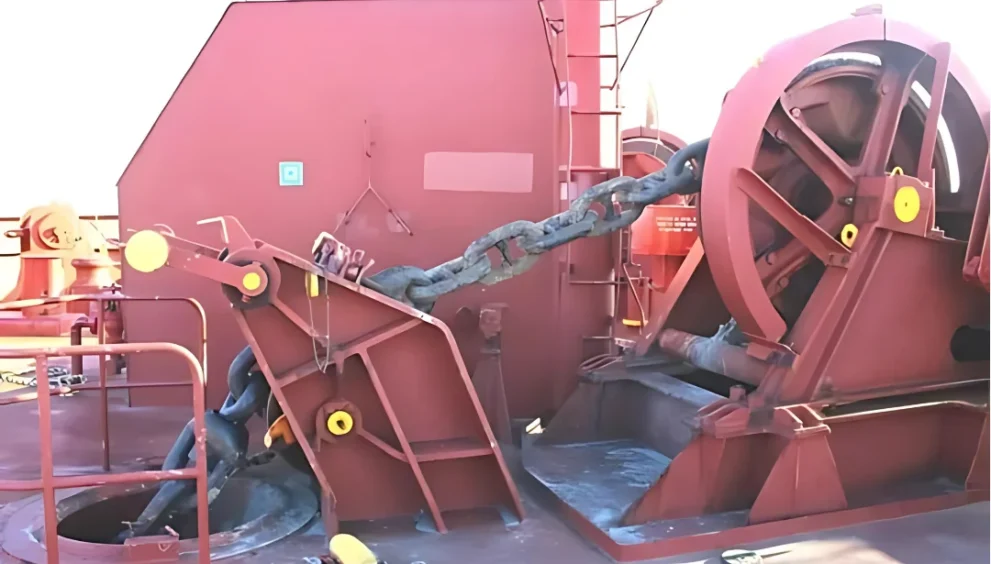Anchor Gear & Equipment
Anchoring is more than a simple operation in merchant shipping; it’s a network of solid apparatus working in harmony under stress. Each smooth process runs on machinery constructed for strength, endurance, and precision. Understanding this setup isn’t just for engineers—it’s vital knowledge for every watchkeeper, cadet, or officer working anchor stations or bridge
1. The Anchor – The First Line of Holding Power
Merchant vessels usually employ:
Stockless Anchor – The standard choice for the majority of commercial ships because it can fit neatly within and function decently well in various seabed.
AC-14 HHP Anchor – Found on most newer ships, lightweight with great holding capacity, particularly desirable where weight reduction is required.
They are designed to bite into the ocean floor under tension, providing stability in wind and current. But even the best anchor can use the assistance of what follows.
2.Anchor chain (cable): Strength between the anchor and the hull. U2 or U3 grade anchor chain is usually used as anchor cable on commercial ships. Large ships require higher tensile strength and should use the stronger U3 grade anchor chain.
Shackle size: 1 shackle is equivalent to 27.5 meters.
The anchor chain is bent in a catenary shape, which can move with the hull and assist the grip of the anchor by applying horizontal tension.
The chain itself plays a massive role in holding power—especially in rough conditions or strong tidal flows.
3. Windlass – The Anchoring Workhorse
The windlass is the primary machine used to deal with the anchor and chain. It’s typically driven hydraulically or electro-hydraulically, depending on the ship’s construction.
This is what gets it going:
Gypsy (or Wildcat): This is the notched wheel that literally holds onto the anchor chain to pull it in or release it.
Brake: As soon as the anchor is lowered, the brake keeps everything stable. It is particularly important in case of a power failure or emergency.
Clutch: Utilized to connect or disengage the power to the gypsy. It facilitates manual use when necessary.
Chain Stopper (such as Devil’s Claw or Guillotine): This component mechanically locks the chain into position, removing the load from the windlass when the anchor is deployed to the fullest extent.
Timing is what matters here—particularly between the clutch and brake. If the brake is not released smoothly or the clutch is picked up too early, things quickly get ugly. Mistakes here can result in runaway chain run-out or even mechanical failure, particularly if the ship is stressed.
4. Hawse Pipe, Spurling Pipe & Chain Locker
The anchor and chain are guided out through the hull by the Hawse pipe.
The spurling pipe directs the chain into the locker.
When not in use, the anchor cable is kept in the chain locker.
The chain locker should be well-ventilated and drained. Moisture accumulated can cause serious rusting, and in extreme cases, even gas buildup—making regular inspection a safety necessity.
5. Chain Markings – For Control During Operation
Most merchant vessels employ a combination of:
Painted links (using standardized colour schemes),
Number tags, Removable steel or wire lashings for long-term use.
Paint-only systems do not last long in muddy or rocky seabed. That’s why tagging or wire lashings are a better, longer-term alternative—particularly when working regularly or in abrasive seabed’s.
6. Modern Add-Ons – Going Beyond the Basics Numerous contemporary merchant vessels now incorporate:
Load sensors to monitor chain tension
CCTV cameras at the hawse pipe
Bridge indicators to display anchor status and cable length
Chain speed monitoring systems
These systems enhance bridge awareness and minimize human error in deployment and recovery, especially in adverse visibility or close anchorages.
Technical Checks That Many Overlook:
Test the clutch and brake when loaded, not only when stationary. True tension speaks volumes.
Check chain wear on the inside of links, not merely the flat areas visible—cracks tend to begin where eyes fail to look.
Check hydraulic pressure prior to windlass operation—a poor start usually leads back to low reservoir levels or system air.
These aren’t additional checks—they’re habits that distinguish sharp officers from mediocrity.
Final Word:
Anchor systems on merchant navy vessels are a great deal more than mechanical niceties—they’re safety-critical items that must work under load, time, and stress. From anchor fluke to chain locker, every item commands respect, care, and knowledge.
Whether you’re giving orders from the bridge or waiting in reserve at the forecastle, understanding the equipment you’re depending on is not a choice—it’s a must.


